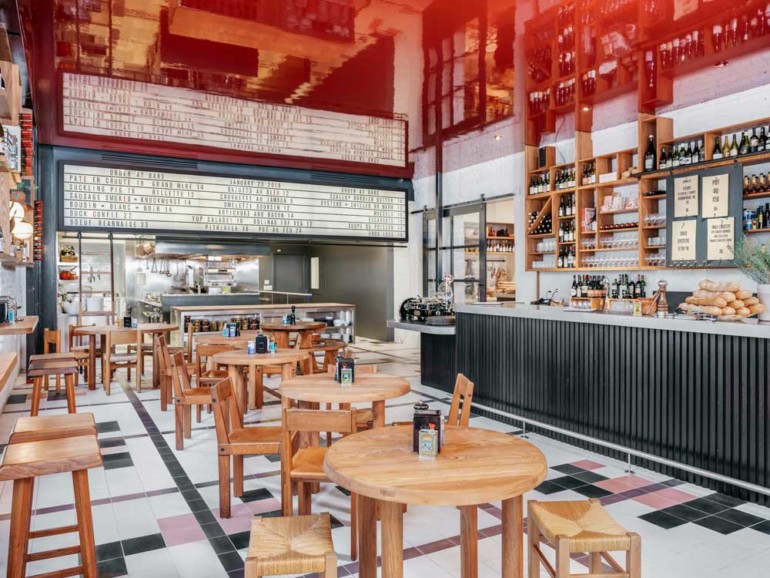RESTAURATEURS MICHAEL AND LINDSAY TUSK of Michelin-starred Quince and Cotogna fame developed a fondness for caves à manger — casual, order-at-the-bar, all-in-one wine bars and wine stores — while holidaying in England, Spain and France. L’Avant Comptoir, Le Dauphin and Juveniles became their magnets in Paris. Thus inspired, they recently launched Verjus (Ver-joo), a French-style cave à manger in an 1840s brick Victorian — still standing in shiny, technology-forward San Francisco.
This deliberately chaotic drop-in gathering spot, where delicious house-made sausages and charcuterie — some served like Spanish pintxos at stand-up tables with single-ply paper napkins — and organic wines are the stars, also brings a much-needed patinated aesthetic to Jackson Square, one of the city’s oldest quarters.
Lindsay Tusk and the firm Jensen Architects achieved Verjus’ unpretentious vibe and shopworn bohemian look (vinyl records belt out jazz, reggae and punk tunes) in stages. First, they combined two adjacent spaces — one a former restaurant and the other a dark, dowdy office — by cutting open a connecting doorway that flanks a hand-built ebonized wood and black slate bar with a full view of the dining room as well as the open kitchen.
The floor — flowing seamlessly out from the kitchen — is covered with impervious colored encaustic cement tiles from Spain supplied by London’s Lindsey Lang. Laid out painstakingly by Tusk in a grid pattern, the floor has directional motifs that never repeat, and, already settling, it sports a creeping crack Tusk loves.

Tusk, whose mother was an interior designer and whose father was an engineer, has what she calls design DNA.
“Dining is a visual experience at and around the table, and lighting is most critical,” she says. So while the space is generally dimmed for atmosphere, it has bright spots making it easier to read chalkboards behind the bar and in the adjacent wine shop. The midcentury modern Luigi Caccia Dominioni– and Gino Sarfatti– designed globe pendants are from Parma, Italy.
Vintage mahogany wood louvers, set on new pivots, modulate light from street windows. Above the kitchen service counter that doubles as a chef ’s table is a backlit movie marquee with menu items listed in large letters.

And, the tour de force, inspired by red clarets, is a glossy red lacquered 14-foot-high ceiling that mirrors the action below. It also complements new shelving by Michael Mellon and Ben Winslow and sturdy round/square, old/ new Pierre Chapo elm wood furniture, designed during the ’60s and ’70s for French architect Charlotte Perriand.
While shopping for Verjus, Tusk also found unusual dining accessories and kitchen tools, now stocked for sale inside an 1890s Florentine apothecary’s vitrine that adds a vaguely residential touch to the wine store.
“It’s all visually interesting but there’s nothing really new here,” Tusk says. And that perhaps is exactly the point.
This article originally appeared in Spaces’ print edition under the headline: “Verjus: New, Satisfying, Familiar.”


